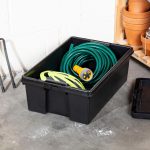Outdoor storage areas like sheds, workshops, or garages can make the perfect breeding ground for mould. To keep your belongings protected, there are ways to stop mould from forming in the first place.
Read more to find out our top tips for preventing mould in your garage or shed, and how to deal with it once it’s grown.
How to prevent mould in your shed or garage
Only store dry items
The main cause of mould is excess moisture, so limiting the number of wet items you store will help to keep mould at bay.
Try to dry off bikes, camping equipment, or anything else that might be carrying excess water. You should also try and store your items on a shelf instead of on the floor, to allow for air circulation and to reduce the chance of absorption.
Seal your windows and doors
Since you’re trying to keep out moisture, you’ll want to make sure that your space is watertight. Check your door and window seals for any damage or deterioration and replace them if necessary.
Try and absorb moisture
The air naturally contains water, so you’ll want to try and reduce the amount where you can. If your shed or garage has power, you can use a dehumidifier to wick away moisture or try a natural remedy if not – silica gel packs, rock salt, and even cat litter can be used to absorb water in the air over time.
Regularly ventilate your shed
Particularly over the winter, the air temperature inside and outside your shed or garage can be vastly different causing condensation which becomes a breeding ground for mould.
To keep condensation at a minimum, try to open the doors or windows every so often to get the air moving. Allowing some regular airflow will help to regulate the temperature between the inside and outside, reducing the chance of mould growing.
Add insulation
In the same way, insulation will help to keep a regulated temperature to limit any moisture buildup.
How to remove mould in your shed or garage
If you’ve already discovered mould in your shed or garage, it can be tough to remove. Your best bet is to give everything a good clean.
First, empty out all your belongings (and make sure there’s no mould on anything you’ve stored either). Then use either a dedicated mould cleaner or a mix of bleach and water to thoroughly clean any affected areas.
It can be tricky to remove mould once it’s taken hold, so preventative methods are your best option to try and avoid it appearing in the first place.
With your garage, shed, or other outdoor space now ready for the winter, you shouldn’t have to worry about fighting mould in the spring.


